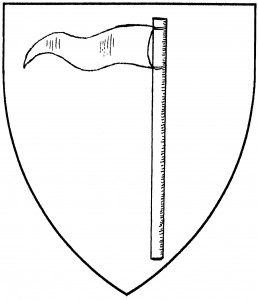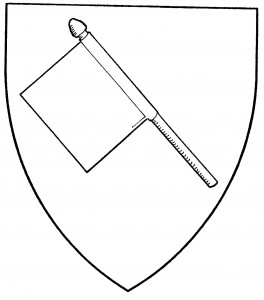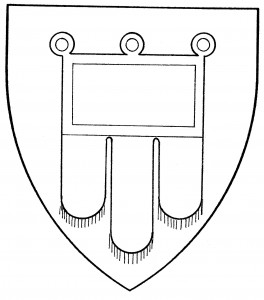A flag is a piece of cloth attached to a pole, allowed to fly in the breeze. Flags are normally found as artistic details on castles, ships, &c; they’re usually termed “pennons” in such cases. However, flags are sometimes found as charges in their own right. Flags typically stream to dexter (i.e., the pole is in sinister), but the detail is worth no difference and may safely be left unblazoned.
There are some other special terms for different types of flags: A “banner” is a square or rectangular flag on a staff, as in the civic arms of Würtzburg, 1413 [Conz.Const. cvi]. A “gonfanon” is a rectangular or heater-shaped flag, hung from ropes at its top corners, as in the arms of the Counts of Auvergne, c.1275 [Asp2 220]. A “wyn” is a stiff triangular vane; it is mostly used for the sake of a cant.
In Society armory we find the “vexillum”, a standard borne by maniples of the Roman army; it denoted lesser rank than the aquila or eagle standard.
Flags are considered a medium for heraldic display. Thus when used as a charge in Society heraldry, the design on a flag is also checked for conflict. An uncharged flag is not considered presumptuous.
See also sail.
Stoth, Stomper of the Gilded Moth bears: Or, two square flags in saltire azure and vert, surmounted by another palewise gules, all staved proper.
Alroy Cullen bears: Argent, in bend two pennoncelles fesswise gules flying to dexter from two wooden staves palewise proper, the dexter staff surmounted by the sinister pennoncelle.
Goldwyn of Britain bears as a badge: A wyn Or.
Thomas d’Orleans bears as a badge: Azure, upon a Roman vexillum issuant from base Or the letters A E T I sable.
Eldrich Gaiman bears as a badge: A gonfanon counter-ermine.



